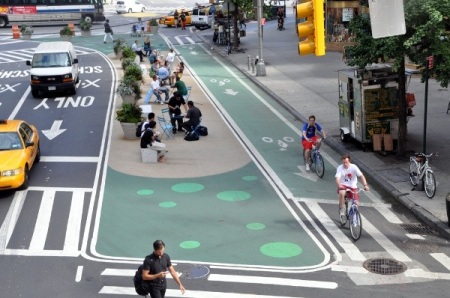The upgrades to the Burrard Cornwall intersection are almost finished. The improvements include separated bike lanes from the Bridge along Cornwall to Cypress and along Burrard south to 1st Avenue. These badly needed improvements are fantastic and will help encourage more people of all ages to ride bicycles both for daily trips and recreation.
Sewer, water and road construction work is scheduled on Burrard from 1st Avenue to 16th Avenue starting in 2015. This presents an idea opportunity for the City to improve Burrard Street for cycling and walking building upon the great work on Burrard Bridge and the Cornwall intersection.
Currently, Burrard south of 1st is a miserable place to cycle and walk. Typically, the narrow sidewalks are right next to the speeding traffic. In spite of the traffic, a significant number of brave souls still cycle on Burrard. For some trips, it is more direct than the alternatives plus there are many businesses and shops along it.
Cypress, the current bike route is not much better north of 4th Avenue. At Cornwall, there are almost 500 vehicles on Cypress in the afternoon peak hour. This around the maximum traffic volume acceptable over 24 hours for a road to be safely and comfortably accommodate cyclists of all ages. Many of vehicles are making turns that will cause conflicts and pose a danger to people cycling.
According to ICBC, both Burrard and Cypress have fairly high levels of cycling collisions. From 2008-2012, there was at least one collision at each intersection from 10th to Cornwall. In 2012, there were 7 collisions from 12th to 1st along Burrard while there were three on the same section of Cypress. In 2011, both streets had five each from 16th to 1st.

2011 Census Cycling Commuting Mode Share – City of Vancouver
As shown in the map, the cycling mode share in areas served by Burrard, Pine and Cypress (6%-9%) is significantly lower than other areas (9%-15%) of Vancouver similar distances from downtown. Moreover, while cycling in the areas east of the Dunsmuir Separated Bike Lanes increased significantly from 2006 to 2011, areas to the south of the Hornby and Burrard Separated Bike Lanes did not increase over this period. This is likely due to the lower quality of the bike routes feeding Hornby and Burrard compared to Adanac Bikeway.When Burrard/Pine/Cypress are improved, it would be reasonable to expect cycling levels to increase to 10% to 15%.
Upgrading narrow local streets like Cypress and Pine to accommodate all ages cycling quite challenging. Either enough traffic needs to be diverted off it to reduce volumes to 300-500 vehicles per day or separated bike lanes need to be added. Especially with the diversions introduced with the York Bikeway, diverting traffic off Cypress may be difficult while maintaining basic access for residents and businesses. Furthermore, with the high turnover of customer parking, it may not be possible to reduce levels enough. To add separated bike lanes, parking would need to be stripped from one side of Cypress and the street would need to be converted to one way. Some residents and businesses won’t be too keen on this either.
Burrard, on the other hand, is wide enough to accommodate separated bike lanes while maintaining access and parking at least during off-peak hours. While the number of travel lanes between intersections would need to be reduced from three to two, right turn lanes would help maintain vehicle capacity near current levels.

Possible lane configuration for Burrard just south of 4th Ave
One option worth considering is one-way separated bike lanes (cycle tracks), on both sides of Burrard from 1st Avenue to at least 10th Avenue. On two-way streets with a lot of cars turning at intersections and driveways on boths sides, cycle tracks can be safer than a two-way path on one side.

Possible lane configuration for Burrard just south of 5th Ave. On-street parking could be allowed evenings, weekends and off-peak weekdays.
Burrard provides obvious direct connections to Burrard Bridge. Using either Cypress or Pine will result in cycling longer for some trips and may involve crossing busy Burrard more times. People that drive who are considering cycling will know that Burrard is a bicycle route. They may never realize that side streets like Cypress are bike routes.
Having the cycle track between the traffic and the sidewalk will make Burrard much more pleasant to walk along. And, as with the case with Hornby, collisions will likely be reduced making the street safer for everyone, including people in cars. The City should quickly study options for improving Burrard, Pine and Cypress to determine the best options before the planned work starts on Burrard.
Take Action A good idea to write Mayor and Council, mayorandcouncil@vancouver.ca, thanking them for the Burrard Cornwall intersection improvements and encourage them to make Burrard, Cypress and Pine better for all ages cycling.











